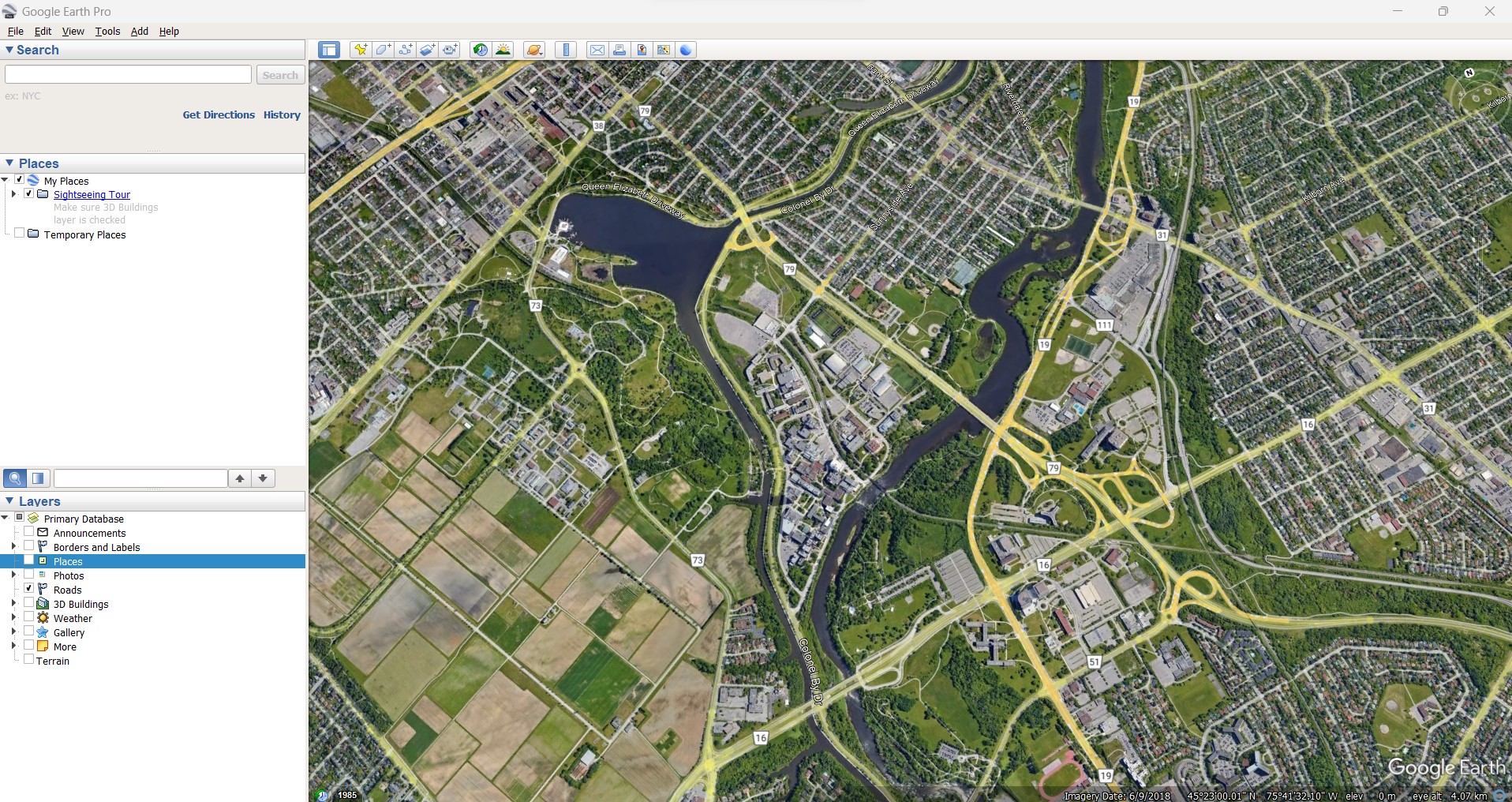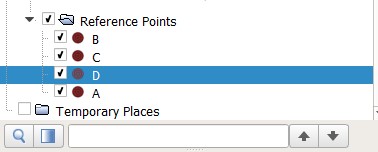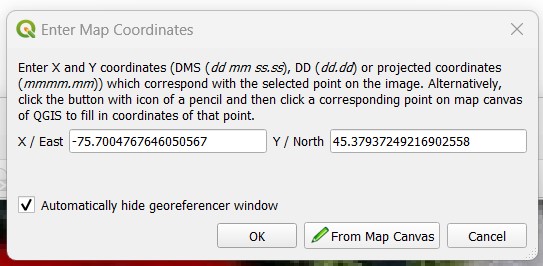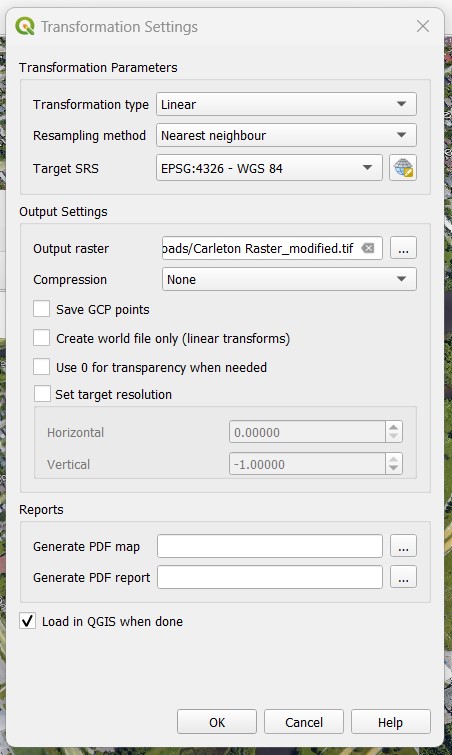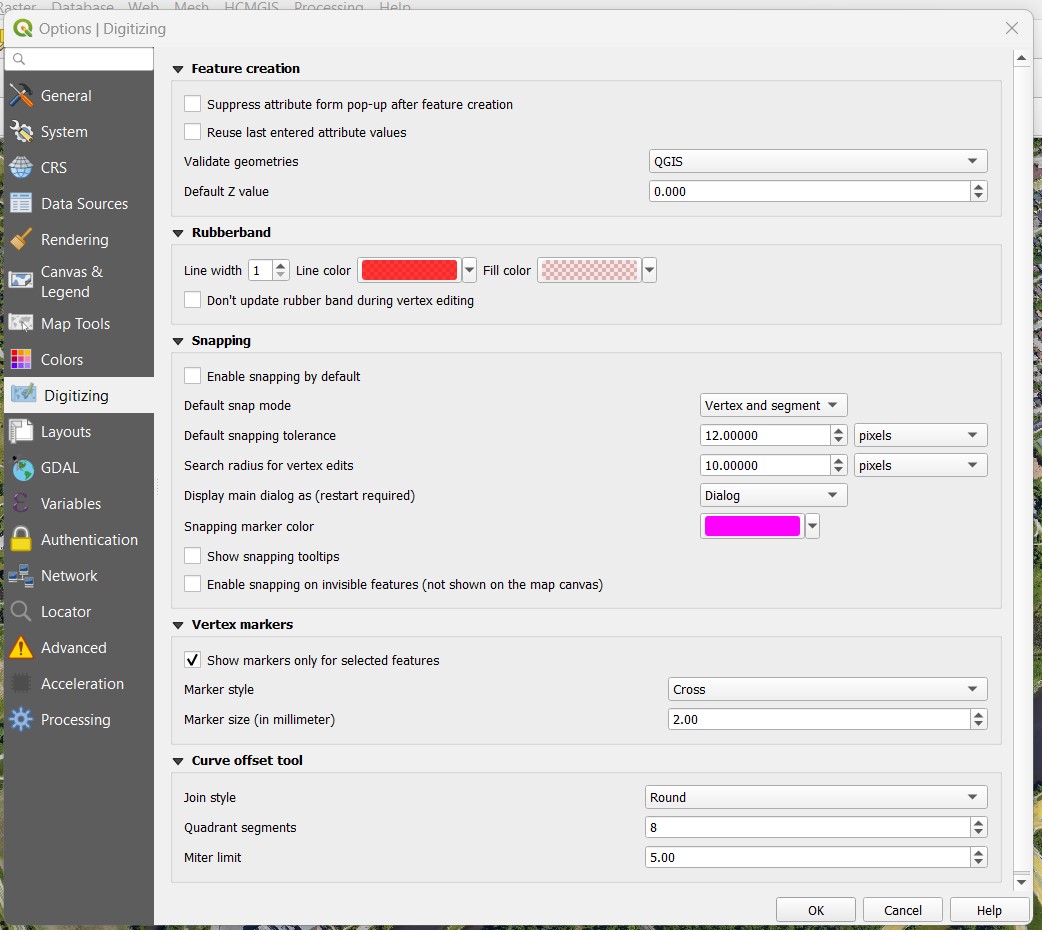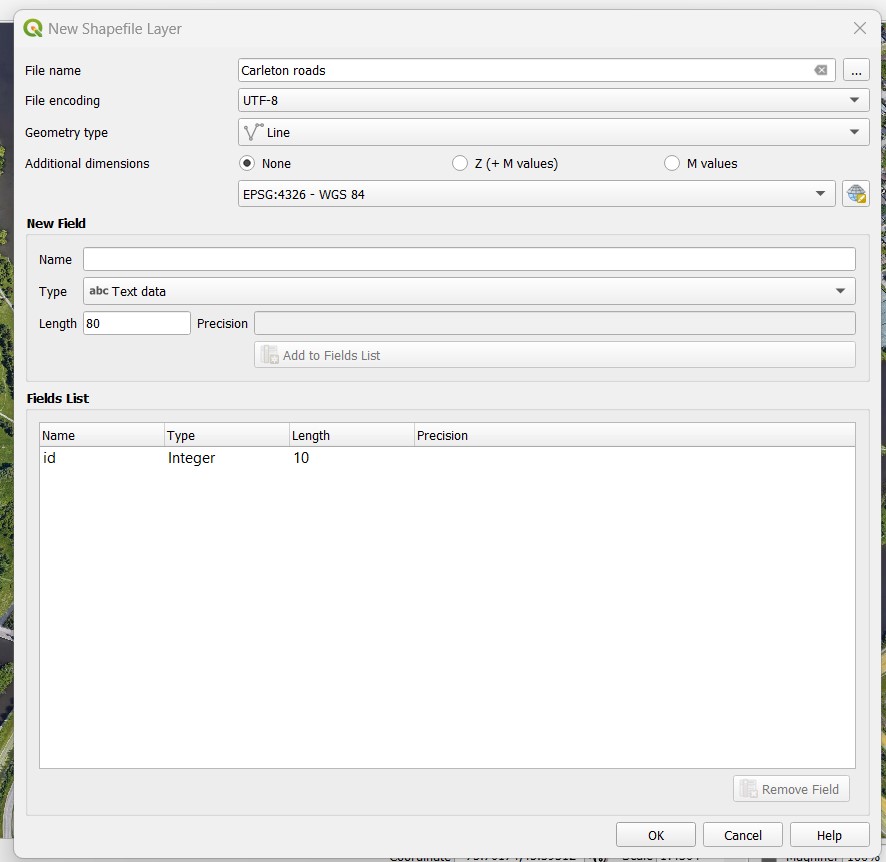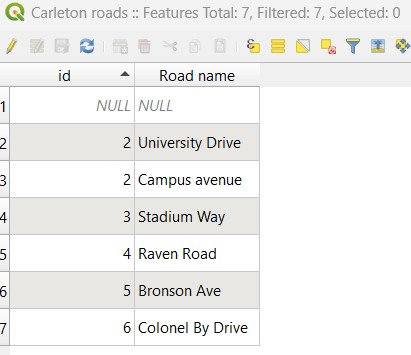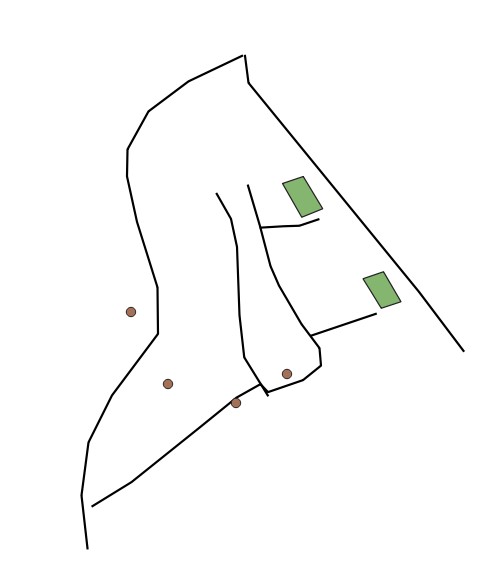Difference between revisions of "Digitizing and Georeferencing in QGIS"
Nata Culhane (talk | contribs) |
|||
| (29 intermediate revisions by 3 users not shown) | |||
| Line 1: | Line 1: | ||
== Introduction == |
== Introduction == |
||
| − | This tutorial will demonstrate |
+ | This tutorial will demonstrate georeferencing and digitizing features in QGIS, using imagery downloaded from Google Earth Pro. Georeferencing is the process of taking a digital image, air-photo, or scanned topographic map, and using spatial data or coordinates to locate the image in the real world using GIS software (USGS, 2023). Essentially, georeferencing ties an image to the coordinate system used on earth, allowing for digital map analysis (point-and-click for coordinates, calculate area and distance, etc) (USGS, 2023). It links known reference points to the earth in order to georeference the entire image. Digitization is a process where geographic data in a hardcopy or a scanned image form is converted into vector data by tracing the features as either points, lines, or polygons, to convert georeferenced data to a digital format, such as a shapefile (ArcGIS Developers, 2023). Both digitizing and georeferencing are useful skills to learn, as they allow users to easily determine real-world spatial information from an image, such as knowing coordinates and distances. They are also always the first processes when analyzing a scanned or hardcopy map, so they are good basic skills to master. Extra tutorials and readings on this topic are linked in the References and Resources section for your convenience. |
| + | |||
| + | The first section of this tutorial will focus on georeferencing, starting by downloading Google Earth imagery and reference points, then bringing these into QGIS and starting the georeferencing tool, tying reference points to the image, and finally producing the finished georeferenced file. The second section of the tutorial will use the georeferenced image from part 1 to explain basic digitizing skills, creating point, line, and polygon shapefiles from the image. |
||
== Software == |
== Software == |
||
| − | + | Georeferencing can be done in a variety of GIS software. Here, QGIS is used. Quantum GIS (QGIS) is a free, open source software (FOSS) that allows users to interact with geospatial data and analysis tools similarly to with more advanced programs. It supports various datasets such as vector and raster, several plug-ins and database formats, and lets the user browse and create map data on their computer. This tutorial also uses Google Earth Pro, which is another free program that allows users to create point KML files, download images, and even do simple map analysis like calculating distance. |
|
== Data == |
== Data == |
||
| − | The first step is to locate a suitable historical image to georeference. |
+ | The first step is to locate a suitable historical image to georeference. These can be found in many places online, but in this tutorial, it was obtained from Google Earth Pro. Regardless of where the data is obtained from, it is essential to also download or create reference/ control points to go along with the image. These points are what will be used later to actually georeference the image. |
| + | |||
| + | In this example, Carleton University was located on Google Earth Pro (see image below). |
||
| + | |||
| + | [[File:Figure 1!!.jpg|frame|center|Carleton University's campus was located on Google Earth Pro, to be used as the example data for this tutorial]] |
||
| + | |||
| + | Once you are happy with the location you've selected, go into Options > Navigation, and make sure that 'do not automatically tilt while zooming' is checked. As well, in the main menu, turn off Terrain. This will ensure that your image is flat and easy to work with in QGIS. |
||
| + | |||
| + | Next, create your reference points. The more points, the more accurate the georeferenced file will be, but a good basic number to start with is four - one in each corner of the image or area you are interested in. In the contents pane on the left of the screen, create a new folder, name it 'reference points', and move the four points into the folder. See images below. |
||
| + | |||
| + | [[File:Figure 2!!!.jpg|frame|center|Reference points are added to the image in Google Earth Pro]] |
||
| + | [[File:Figure 3!!!.jpg|frame|center|Creating a folder of reference points in Google Earth Pro]] |
||
| + | |||
| + | Finally, you are ready to export your image and reference points. To save the reference points, right-click the folder, hit save place as, and ensure you are saving a KML file. To save the map, make sure all points are visible in your view and the compass is oriented to north, then go to File> Save> Save Image. Turn off extra map options (like the title, etc), and choose the highest file size. Save as a JPEG. |
||
== Tutorial for Georeferencing with QGIS == |
== Tutorial for Georeferencing with QGIS == |
||
| Line 15: | Line 30: | ||
With QGIS software open, the first step is to check whether the Georeferencer plugin is installed: |
With QGIS software open, the first step is to check whether the Georeferencer plugin is installed: |
||
| − | * Under the Plugins menu, |
+ | * Under the Plugins menu, click on Manage and Install Plugins. |
| + | |||
| − | * In the QGIS Plugin Manager Dialog box search for Georeferencer GDAL. |
||
| + | * In the QGIS Plugin Manager dialog box search for Georeferencer GDAL. |
||
| − | * Ensure it is installed as shown below. Click Close. |
||
| + | |||
| − | |||
| + | * Ensure it is installed. Also, make sure the checkbox is checked, this will make it appear in the toolbar. Click Close. |
||
| + | |||
| + | |||
| + | Next, open the Google Earth image to georeference: |
||
| − | + | * Click on the Raster tab and launch the Georeferencer. |
|
| − | + | * Click the Add Raster Layer icon. |
|
| + | |||
| − | On the dialog that appears, change the Files of Types to JPEG. |
||
| − | + | * Browse to the location where we have the Google Earth image, select it and open it. |
|
| + | |||
| − | Click on the image to select it the click Open. |
||
| − | + | * If the Coordinate Reference System Selector dialog opens, ensure the coordinate is set to the correct one for your location, then click Okay. |
|
| + | |||
| − | On the Raster menu, click on the Georeferencer. |
||
| − | + | * On the Raster menu, click on the Georeferencer. |
|
| + | |||
| − | |||
| + | * Click the Open Raster tool and select the raster file. |
||
| − | |||
| + | |||
| − | Table showing the coordinates from google earth |
||
| + | |||
| − | Point Eastings Northings |
||
| + | Next, open the reference points file: |
||
| − | A 633042.00 4833849.00 |
||
| + | |||
| − | B 634243.00 4833890.00 |
||
| + | * To import reference points, select Layer > Add Vector Layer, and open the reference points KML |
||
| − | C 634135.00 4833174.00 |
||
| + | |||
| − | D 633142.00 4833155.0 |
||
| + | |||
| + | Now, all data needed for the georeferencing process are open in QGIS. Start by tying points on the image to the reference point file: |
||
| + | |||
| + | * Zoom in to point A of the image. |
||
| + | |||
| + | * Click on the Add Points button |
||
| + | |||
| + | * On the raster, click on the corner point, the Enter Map Coordinates dialog will appear |
||
| + | |||
| + | * Select 'from map canvas'. This will allow you to click on your reference points instead of typing the coordinates in by hand. You can always edit them if they are off. |
||
| + | |||
| + | * Navigate to the correct point on your main map canvas, click it, and click Okay. |
||
| + | [[File:Figure 4!!.jpg|frame|center|Entering map coordinates]] |
||
| − | Zoom in to point A of the image. |
||
| − | Click on the Add Points button |
||
| − | On the raster, click on the corner point, the Enter map coordinates dialog will appear |
||
| − | Click OK. |
||
| − | |||
| + | * Repeat for all the other corners. You can also decide to save the GCPs, load GCPs, delete point or remove GCP point. See Figure 5 below. |
||
| + | [[File:Figure 5!!!.jpg|frame|center|Points all added to the Google Earth image]] |
||
| − | Key-in the corner coordinates (GCPs) and repeat for all the other three corners. You can decide to save the GCPs, load GCPs, delete point or remove GCP point. |
||
| − | Click on Start georeferencing button to create the new georeferenced raster. |
||
| − | Click OK on the Info dialog if asked to set transformation type. |
||
| − | Fill the transformation settings dialog as shown in the figure that follows. |
||
| − | |||
| + | |||
| − | At this point the raster should be now Geo-referenced. |
||
| + | Now that all points are added, you can start georeferencing: |
||
| + | |||
| + | * Click on the Start Georeferencing button (green play button) to create the new georeferenced raster. |
||
| + | |||
| + | * Click Okay on the info dialog when asked to set transformation type. |
||
| + | |||
| + | * Fill in the transformation settings dialog as shown in the figure that follows. Ensure you have 'Load in QGIS when done' checked off. |
||
| + | |||
| + | [[File:Figure 5!!.jpg|frame|center|Transformation settings dialog]] |
||
| + | |||
| + | If you would like to see that the georeference worked, you can perform a quick test: |
||
| + | |||
| + | * Add any default base map to the main canvas, where your new file should have opened |
||
| + | |||
| + | * Turn on and off your image, and see if the points stay in the same place on the map (see Figure 7 below) |
||
| + | |||
| + | [[File:Figure 7.jpg|frame|center|Testing that georeferencing worked]] |
||
| + | |||
| + | ==Tutorial for Digitizing with QGIS== |
||
| + | |||
| + | Digitizing is one of the most frequent duties assigned to a GIS Specialist. Often, a significant portion of GIS effort is spent digitizing raster data in order to create vector layers for analysis. QGIS includes robust on-screen digitizing and editing features, which we shall investigate in this section of the tutorial. |
||
| + | |||
| + | * Go to Layer > Add Raster Layer. Locate the georeferenced image and click Open. |
||
| + | |||
| + | * Set the default Digitizing Options. Go to Settings > Options, and set similar to as shown in the image below: |
||
| + | |||
| + | [[File:Figure 8!.jpg|frame|center|Setting digitizing options]] |
||
| + | |||
| + | * Select the Digitizing tab in the Options dialog. Set the Default snap mode to 'to vertex and segment'. Click Okay. |
||
| + | |||
| + | * Select Layer > Create Layer> New Shapefile. First, try digitizing line features, such as roads. Here, the main roads on Carleton's campus were digitized. |
||
| + | [[File:Figure 9!!.jpg|frame|center|Creating a new shapefile]] |
||
| − | Digitizing tool |
||
| − | Digitizing is one of the most frequent duties assigned to a GIS Specialist. Often, a significant portion of GIS effort is spent digitizing raster data in order to create vector layers for analysis. QGIS includes robust on-screen digitizing and editing features, which we shall investigate in this course. |
||
| − | Procedure |
||
| − | Go to Layer ‣ Add Raster Layer. Locate the georeferenced image and click Open |
||
| − | Set the default Digitizing Options. Go to Settings ‣ Options… |
||
| + | * Once the layer is loaded, click the Toggle Editing button to put the layer in editing mode. |
||
| + | * Click the Add feature button. Click on the map canvas to add a new vertex. Add new vertices along the road features. Once you have digitized a road segment, right-click to end the feature. |
||
| − | Select the Digitizing tab in the Options dialog. Set the Default snap mode to To vertex and segment. |
||
| − | Click OK. |
||
| − | Click on Layer then create layer then new shapefile |
||
| − | |||
| + | * If the features you are digitizing have names or other identifiers you would like to keep on hand, you can edit the attribute table (right-click the new .shp, open the attribute table, and toggle editing on to add a field and fill it in for each new feature). Here, the names of the roads were included. |
||
| − | |||
| + | |||
| − | Once the layer is loaded, click the Toggle Editing button to put the layer in editing mode. |
||
| + | [[File:Figure 9.5!.jpg|frame|center|Attribute table for Carleton roads file]] |
||
| − | Click the Add feature button. Click on the map canvas to add a new vertex. Add new vertices along the road feature. Once you have digitized a road segment, right-click to end the feature. |
||
| + | |||
| − | Once you have finished digitizing all the roads, click the Toggle Editing button. |
||
| + | * Once you have finished digitizing all the roads, click the Toggle Editing button off. |
||
| + | |||
| + | [[File:Figure 10!.jpg|frame|center|Carleton's roads digitized in a new shapefile]] |
||
| + | |||
| + | * Try digitizing some polygon features (here, Carleton's sports fields were done), and point features (here, outdoor study spots were done). |
||
| + | |||
| + | * When you are done, try turning the original georeferenced image off to see your new shapefiles. |
||
| + | |||
| + | [[File:Figure 11!!.jpg|frame|center|Complete digitized files]] |
||
| + | |||
| + | == Conclusion == |
||
| + | In this tutorial, you have learned how to: |
||
| + | |||
| + | * Download reference points and imagery directly from Google Earth Pro |
||
| + | |||
| + | * Use QGIS to georeference Google Earth imagery |
||
| + | |||
| + | * Use QGIS to digitize georeferenced files |
||
| + | |||
| + | == References and Resources == |
||
| + | |||
| + | ArcGIS Developers. (2023). Geo-Referencing and Digitization of Scanned Maps. ArcGIS. https://developers.arcgis.com/python/guide/geo-referencing-and-digitization-of-scanned-maps/ |
||
| + | * This page includes more advanced georeferencing and digitizing tips specific to scanned maps |
||
| + | |||
| + | GIS University. (n.d.). Georeferencing in QGIS. GIS University. https://gis-university.com/georeferencing-in-qgis/ |
||
| + | * This tutorial follows similar procedures to those encountered in this tutorial, but is more specific to georeferencing scanned paper maps. |
||
| + | |||
| + | Q-Tips. (2018, October 10). QGIS Georeferencing Google Earth Images. [Video]. YouTube. https://www.youtube.com/watch?v=RjkZgE_WVBk |
||
| + | * This tutorial follows similar procedures to those encountered in this tutorial, and may be useful for more visual learners. |
||
| + | |||
| + | USGS. (2023). What does ‘georeferenced’ mean?. USGS. https://www.usgs.gov/faqs/what-does-georeferenced-mean#:~:text=Georeferencing%20means%20that%20the%20internal,ground%20system%20of%20geographic%20coordinates |
||
| + | * More information about georeferencing and its uses |
||
| + | |||
| + | [[Digitizing_in_QGIS|CUOSG Wiki - Digitizing in QGIS]] |
||
| + | * Another tutorial from the CUOSG Wiki that gets into more advanced digitizing - a great resource to look into once you've gotten the hang of the basics from this one! |
||
Latest revision as of 13:48, 25 September 2023
Contents
Introduction
This tutorial will demonstrate georeferencing and digitizing features in QGIS, using imagery downloaded from Google Earth Pro. Georeferencing is the process of taking a digital image, air-photo, or scanned topographic map, and using spatial data or coordinates to locate the image in the real world using GIS software (USGS, 2023). Essentially, georeferencing ties an image to the coordinate system used on earth, allowing for digital map analysis (point-and-click for coordinates, calculate area and distance, etc) (USGS, 2023). It links known reference points to the earth in order to georeference the entire image. Digitization is a process where geographic data in a hardcopy or a scanned image form is converted into vector data by tracing the features as either points, lines, or polygons, to convert georeferenced data to a digital format, such as a shapefile (ArcGIS Developers, 2023). Both digitizing and georeferencing are useful skills to learn, as they allow users to easily determine real-world spatial information from an image, such as knowing coordinates and distances. They are also always the first processes when analyzing a scanned or hardcopy map, so they are good basic skills to master. Extra tutorials and readings on this topic are linked in the References and Resources section for your convenience.
The first section of this tutorial will focus on georeferencing, starting by downloading Google Earth imagery and reference points, then bringing these into QGIS and starting the georeferencing tool, tying reference points to the image, and finally producing the finished georeferenced file. The second section of the tutorial will use the georeferenced image from part 1 to explain basic digitizing skills, creating point, line, and polygon shapefiles from the image.
Software
Georeferencing can be done in a variety of GIS software. Here, QGIS is used. Quantum GIS (QGIS) is a free, open source software (FOSS) that allows users to interact with geospatial data and analysis tools similarly to with more advanced programs. It supports various datasets such as vector and raster, several plug-ins and database formats, and lets the user browse and create map data on their computer. This tutorial also uses Google Earth Pro, which is another free program that allows users to create point KML files, download images, and even do simple map analysis like calculating distance.
Data
The first step is to locate a suitable historical image to georeference. These can be found in many places online, but in this tutorial, it was obtained from Google Earth Pro. Regardless of where the data is obtained from, it is essential to also download or create reference/ control points to go along with the image. These points are what will be used later to actually georeference the image.
In this example, Carleton University was located on Google Earth Pro (see image below).
Once you are happy with the location you've selected, go into Options > Navigation, and make sure that 'do not automatically tilt while zooming' is checked. As well, in the main menu, turn off Terrain. This will ensure that your image is flat and easy to work with in QGIS.
Next, create your reference points. The more points, the more accurate the georeferenced file will be, but a good basic number to start with is four - one in each corner of the image or area you are interested in. In the contents pane on the left of the screen, create a new folder, name it 'reference points', and move the four points into the folder. See images below.
Finally, you are ready to export your image and reference points. To save the reference points, right-click the folder, hit save place as, and ensure you are saving a KML file. To save the map, make sure all points are visible in your view and the compass is oriented to north, then go to File> Save> Save Image. Turn off extra map options (like the title, etc), and choose the highest file size. Save as a JPEG.
Tutorial for Georeferencing with QGIS
With QGIS software open, the first step is to check whether the Georeferencer plugin is installed:
- Under the Plugins menu, click on Manage and Install Plugins.
- In the QGIS Plugin Manager dialog box search for Georeferencer GDAL.
- Ensure it is installed. Also, make sure the checkbox is checked, this will make it appear in the toolbar. Click Close.
Next, open the Google Earth image to georeference:
- Click on the Raster tab and launch the Georeferencer.
- Click the Add Raster Layer icon.
- Browse to the location where we have the Google Earth image, select it and open it.
- If the Coordinate Reference System Selector dialog opens, ensure the coordinate is set to the correct one for your location, then click Okay.
- On the Raster menu, click on the Georeferencer.
- Click the Open Raster tool and select the raster file.
Next, open the reference points file:
- To import reference points, select Layer > Add Vector Layer, and open the reference points KML
Now, all data needed for the georeferencing process are open in QGIS. Start by tying points on the image to the reference point file:
- Zoom in to point A of the image.
- Click on the Add Points button
- On the raster, click on the corner point, the Enter Map Coordinates dialog will appear
- Select 'from map canvas'. This will allow you to click on your reference points instead of typing the coordinates in by hand. You can always edit them if they are off.
- Navigate to the correct point on your main map canvas, click it, and click Okay.
- Repeat for all the other corners. You can also decide to save the GCPs, load GCPs, delete point or remove GCP point. See Figure 5 below.
Now that all points are added, you can start georeferencing:
- Click on the Start Georeferencing button (green play button) to create the new georeferenced raster.
- Click Okay on the info dialog when asked to set transformation type.
- Fill in the transformation settings dialog as shown in the figure that follows. Ensure you have 'Load in QGIS when done' checked off.
If you would like to see that the georeference worked, you can perform a quick test:
- Add any default base map to the main canvas, where your new file should have opened
- Turn on and off your image, and see if the points stay in the same place on the map (see Figure 7 below)
Tutorial for Digitizing with QGIS
Digitizing is one of the most frequent duties assigned to a GIS Specialist. Often, a significant portion of GIS effort is spent digitizing raster data in order to create vector layers for analysis. QGIS includes robust on-screen digitizing and editing features, which we shall investigate in this section of the tutorial.
- Go to Layer > Add Raster Layer. Locate the georeferenced image and click Open.
- Set the default Digitizing Options. Go to Settings > Options, and set similar to as shown in the image below:
- Select the Digitizing tab in the Options dialog. Set the Default snap mode to 'to vertex and segment'. Click Okay.
- Select Layer > Create Layer> New Shapefile. First, try digitizing line features, such as roads. Here, the main roads on Carleton's campus were digitized.
- Once the layer is loaded, click the Toggle Editing button to put the layer in editing mode.
- Click the Add feature button. Click on the map canvas to add a new vertex. Add new vertices along the road features. Once you have digitized a road segment, right-click to end the feature.
- If the features you are digitizing have names or other identifiers you would like to keep on hand, you can edit the attribute table (right-click the new .shp, open the attribute table, and toggle editing on to add a field and fill it in for each new feature). Here, the names of the roads were included.
- Once you have finished digitizing all the roads, click the Toggle Editing button off.
- Try digitizing some polygon features (here, Carleton's sports fields were done), and point features (here, outdoor study spots were done).
- When you are done, try turning the original georeferenced image off to see your new shapefiles.
Conclusion
In this tutorial, you have learned how to:
- Download reference points and imagery directly from Google Earth Pro
- Use QGIS to georeference Google Earth imagery
- Use QGIS to digitize georeferenced files
References and Resources
ArcGIS Developers. (2023). Geo-Referencing and Digitization of Scanned Maps. ArcGIS. https://developers.arcgis.com/python/guide/geo-referencing-and-digitization-of-scanned-maps/
- This page includes more advanced georeferencing and digitizing tips specific to scanned maps
GIS University. (n.d.). Georeferencing in QGIS. GIS University. https://gis-university.com/georeferencing-in-qgis/
- This tutorial follows similar procedures to those encountered in this tutorial, but is more specific to georeferencing scanned paper maps.
Q-Tips. (2018, October 10). QGIS Georeferencing Google Earth Images. [Video]. YouTube. https://www.youtube.com/watch?v=RjkZgE_WVBk
- This tutorial follows similar procedures to those encountered in this tutorial, and may be useful for more visual learners.
USGS. (2023). What does ‘georeferenced’ mean?. USGS. https://www.usgs.gov/faqs/what-does-georeferenced-mean#:~:text=Georeferencing%20means%20that%20the%20internal,ground%20system%20of%20geographic%20coordinates
- More information about georeferencing and its uses
CUOSG Wiki - Digitizing in QGIS
- Another tutorial from the CUOSG Wiki that gets into more advanced digitizing - a great resource to look into once you've gotten the hang of the basics from this one!
